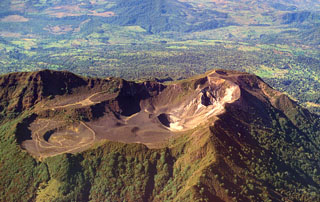Report on Turrialba (Costa Rica) — 9 May-15 May 2018
Smithsonian Institution / US Geological Survey
Weekly Volcanic Activity Report, 9 May-15 May 2018
Managing Editor: Sally Sennert.
Please cite this report as:
Global Volcanism Program, 2018. Report on Turrialba (Costa Rica) (Sennert, S, ed.). Weekly Volcanic Activity Report, 9 May-15 May 2018. Smithsonian Institution and US Geological Survey.
Turrialba
Costa Rica
10.025°N, 83.767°W; summit elev. 3340 m
All times are local (unless otherwise noted)
OVSICORI reported that there were strong emissions of SO2 from Turrialba, accompanied by vigorous fumarolic activity and jetting noises. An ash plume was reported on 10 May, with ashfall in La Pastora de Santa Cruz de Turrialba and Pacayas. A weak water vapor and gas plume was detected at 0920 on 13 May, rising 300-500 m (1000-1600 ft) above the summit. Seismicity was low, with low-amplitude long-period earthquakes and some low-amplitude tremor. Continuous low-amplitude tremor was report on 13 May.
Geological Summary. Turrialba, the easternmost of Costa Rica's Holocene volcanoes, is a large vegetated basaltic-to-dacitic stratovolcano located across a broad saddle NE of Irazú volcano overlooking the city of Cartago. The massive edifice covers an area of 500 km2. Three well-defined craters occur at the upper SW end of a broad 800 x 2200 m summit depression that is breached to the NE. Most activity originated from the summit vent complex, but two pyroclastic cones are located on the SW flank. Five major explosive eruptions have occurred during the past 3500 years. A series of explosive eruptions during the 19th century were sometimes accompanied by pyroclastic flows. Fumarolic activity continues at the central and SW summit craters.
Source: Observatorio Vulcanologico y Sismologico de Costa Rica-Universidad Nacional (OVSICORI-UNA)

